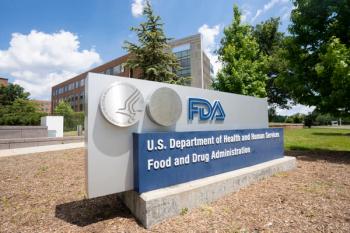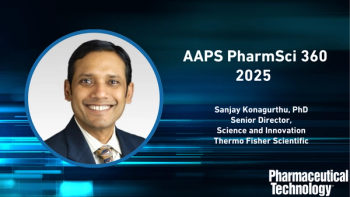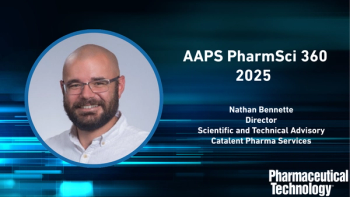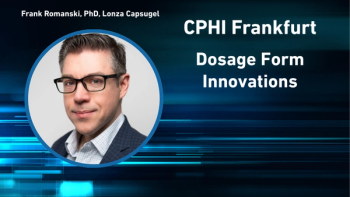
PTSM: Pharmaceutical Technology Sourcing and Management
- PTSM: Pharmaceutical Technology Sourcing and Management-11-10-2009
- Volume 5
- Issue 11
Manufacturing and Regulatory Considerations in Biosimilars
Leading experts from an upcoming conference on biosimilars by the Drug, Chemical, and Associated Technologies Association share their insights on the manufacturing and regulatory considerations for biosimilars.
Biosimilars represent an emerging opportunity for the pharmaceutical industry, but there are challenges and specialized considerations when assessing their potential from both a manufacturing and regulatory perspective. To further understand these issues, Patricia Van Arnum, senior editor with Pharmaceutical Technology and editor of Sourcing and Management, gained the insight from leading experts: Patricia Seymour, a senior consultant with BioProcessTechnology Consultants; Gillian R. Woollett, MA, D. Phil., and chief scientist, with the law firm Engel & Novitt LLP; Carl Lawton, PhD, and director of the Massachusetts Biomanufacturing Center at the University of Massachusetts in Lowell; and Margit Holzer, PhD, and research and development technology director with Novasep. These experts will be speaking at the
PharmTech: In meeting the chemistry, manufacturing, and controls (CMC) requirements for a biosimilar product, a company faces additional challenges as compared with a small-molecule generic product. What would you identify as some of these key challenges or issues in biosimilar process development and manufacturing?
Seymour: One of the most significant challenges in developing a biosimilar product is designing the manufacturing process to achieve comparability to the reference product. Unlike small-molecule drugs that can typically be described by a single chemical formula and duplicated relatively easily, a biologic is produced from living organisms and has significantly more complexity and heterogeneity. All development activities starting as early as the generation of the production cell line through definition of the final purification and process conditions must focus on mimicking the host cell line and process conditions of the reference product in order to drive the process toward producing a similar product. It is rare for innovators to provide details about their manufacturing processes publicly, so the challenge for biosimilar companies is to figure out what the process conditions are likely to be and then mimic them. Rigorous analytical testing must accompany process development to select a production cell line and unit operations that are most likely to produce a product that meets comparability goals.
Innovator companies often implement process changes following market launch, either to meet increased product demand, to obtain second-site manufacturing options, or to improve process economics. These changes can involve any part of the process, including such varied activities as the bioreactor control and media optimization for the scale of operations, the purification process, the manufacturing facility, or other manufacturing conditions. During implementation of major process changes into the commercial manufacturing process, the properties of the resultant product need to be monitored to insure that the process changes result in a comparable product. The concept of a ‘well-characterized biologic’ and the comparability guidelines first issued in the mid-1990s laid the foundation for manufacturers to make changes to the manufacturing process of an existing commercial product without it being considered a new product. This allowed companies to implement changes without redoing time consuming and expensive clinical trials if they could demonstrate biochemical comparability through the use of ‘physicochemical studies and quality-related biological studies.’ There is a significant burden of proof for the innovator company; even the innovator isn’t always successful at demonstrating biochemical comparability, and in such cases, either the process change is rejected or additional clinical studies are required prior to a formal decision by the agency.
While innovator companies face significant regulatory and technical challenges in implementing process changes while retaining and demonstrating comparability, the challenge is even greater for a biosimilar company. Unlike the innovator, the biosimilar company does not have access to a large body of useful information about the product and process, such as a detailed process-development history, historical critical-process-parameter evaluation, analytical-development data, and validated analytical methods. The actual gene, protein, and expression vector sequences are often tightly guarded as well and are not always available to the biosimilar developer. In addition, the preclinical information, especially with respect to the safety profile of demonstrated product and process impurities, is not usually publically available.
PharmTech: Given the challenges in biosimilar development and manufacturing, are there certain types of biologic-based compounds that lend themselves more to biosimilar development than others? How are these issues balanced with the market considerations (i.e., market value of the innovator reference product)?
Seymour: Twenty eight products make up over 87% over the overall biologics pharmaceutical sales value (R. Gal, “Eight Thoughts on Biosimilars,” Bernstein Research, 2008). Of these 28 molecules, the ones most often cited as being attractive biosimilar targets are etanercept, rituximab, bevacizumab, infliximab, and trastuzumab because of their market potential and patent-expiry timing. However, the products that are available as biosimilar targets are generally products that were developed over 15 years ago, even if they were launched more recently than that. As a result, these products are not based on current discovery and development approaches and are not produced using the most advanced biomanufacturing technologies. The biosimilar-development dilemma is whether to focus on matching the innovator’s process or on creating so-called ‘biobetter’ molecules (replacement molecules for current therapeutics that have improved properties), where development can rely on the scientific advances of the past 10 to 20 years to design products that have better characteristics, such as lower immunogenicity, greater efficacy, improved formulations, or other properties leading to less frequent dosing. Molecules with significant changes that lead to these properties would probably not be approved under current or proposed biosimilar regulations, but would be an improvement for the patients and may enable companies to obtain a larger market share of the intended patient population. It is well known that reducing dosing frequency of any injectable medicine is received with great enthusiasm by patients. For example, when Avonex was introduced to the market, it quickly took significant market share from the first interferon-beta product, Betaseron, due to a reduction in dosing frequency from three times a week to two times a week. Such biobetter products could provide stronger competition to both the innovator companies and their direct subsequent biosimilar competition.
PharmTech: For the few biosimilar products that have been approved in Europe, are there certain approaches or insights that the regulators have provided when evaluating the CMC requirements that would be helpful for biosimilar producers?
Seymour: The EU regulatory authority took the approach that a biosimilar product must be shown to be sufficiently similar to a reference product already licensed in the EU so that it can be used for the same indication at the same dose. Additional clinical studies were required to demonstrate that the biosimilar product had the same efficacy in patients as the reference product. These clinical studies must be done in comparison to the reference product; however, the clinical development program can be shorter and less costly than trials for an innovator product, but this will still be a significant cost.
The benefit in a biosimilar-development program is that the risk of failure is reduced because the target and mode of action of the molecule have been well demonstrated through the years of marketed use of the reference product. Further, there is still a clinical and regulatory risk of failure due to small changes in the biosimilar product that might impact clinical efficacy.
One key issue in biosimilar development is the selection of the reference product and the indication. The current regulations in Europe require that the biosimilar developer compare its product to a reference product that is already approved for the intended indication in the intended territory. In the case where multiple innovator products are already on the market, such as for interferon or growth hormone, the choice of reference product can be critical. Innovator companies also argue that if they perform post-market clinical trials in new indications for a branded product and receive marketing authorization for these indications, they are merely enabling the biosimilar companies to enter the market sooner with competitive products for these new indications. Such concerns may lead to companies forgoing or postponing post-market secondary indication trials, thereby preventing patients’ access to potentially valuable therapies and costing companies significant potential revenue.
Woollett: All biologics, whether they are an innovator product representing a totally new molecule and mechanism of action (MOA), a second-generation product (new molecule, shared MOA), or a biosimilar (similar molecule and shared MOA) need their own, entirely independent and complete CMC section. In this sense, a biosimilar is like a generic small-molecule drug where a complete stand-alone CMC section has always been required. However, unlike small-molecule drugs, this CMC section can be expected to be extensive.
If anything, the biosimilar will have more data than the innovator both because the analytical technologies have made so much progress since the innovator product was approved, but most importantly because their sponsor’s dossier will contain extensive comparative data on both its own product (the biosimilar) as well as on the innovator product which it is using as a reference (the previously approved reference product on which the patents have now expired). Indeed, it is likely that the biosimilar sponsor will be analyzing the reference product at a level of detail way beyond that conducted by the innovator sponsor at the point of initial approval, and may well find batch-to-batch variations in the innovator biologic that are previously unknown to anyone, including the FDA. It is to be expected that any parameter that is within the ‘goalposts’ of the innovator’s marketed product can be considered suitable for the biosimilar.
The European regulators, concurrently with reviewing and approving biosimilars in Europe, published with a full public participatory process that included the breadth of the biopharmaceutical industry, a series on guidelines to help inform sponsors as to the anticipated regulatory needs for the development of biosimilar products. As well as specific guidances on ‘classes’ of potential biosimilar products, EMEA [European Medicines Agency] published general guidances on biosimilars. For example, one such general guidance is
PharmTech: In considering the proposals for a regulatory pathway for biosimilars in the US and the existing requirements in Europe, what can you identify as the key differences and common agreement in regulatory consideration of biosimilars?
Woollett: Since the enactment of European legislation creating the specific biosimilars pathway in 2003, and the concurrent and ongoing debate in the US, that then increased with the introduction of the first biosimilars legislation here in September 2006, there has been much discussion of the differences between the two jurisdictions. However, the similarities are far greater than the differences when it comes down to the companies making biologics, the patients consuming them, and the regulatory requirements for the approval of biologics in all principal markets. Many of the same innovator products are already marketed in multiple jurisdictions.
Consistency in the regulatory standards applied to all biologics within a given jurisdiction becomes the priority as first and foremost biosimilars are biologics, and not drugs. Europe uses the current regulatory construct of comparability to evaluate its biosimilars—since this standard has been the FDA’s interchangeability standard for biologics since 1996, it can be considered well established and well understood by both regulators and the regulated industry. Indeed PhRMA [Pharmaceutical Research and Manufacturers of America] and the innovator industry helped developed the FDA guidance on comparability with the agency back in 1996—albeit only to enable manufacturing changes to its own innovator products as back then these were the only biologics that were approved. Nonetheless, the EU has shown that comparability principles can be extrapolated to biosimilars to ensure that they are evaluated to the same appropriately high, data-driven and science-based standards. There have been no reports of unusual safety or efficacy problems with those biosimilars now approved and marketed in Europe. Likewise, the use of comparability by innovators making changes to their own products have elicited remarkably few problems, Eprex being an oft-cited exception. And most of the time-comparability studies have not necessitated clinical studies; however, it is anticipated that these will be needed for the first generations of biosimilars, but perhaps not forever. However, it should be noted that the European statute that enabled biosimilars does not require clinical studies, and nor does the PHS Act in the US, according to which most current biologics are licensed. Ultimately, in the both Europe and US, the discretion lies with the regulators to evaluate that the sponsor has demonstrated quality, safety, and efficacy (Europe), or safety, purity, and potency (US). These standards can pertain to biosimilars and innovator biologics alike. It is only the how and the actual data set that will vary.
Joint efforts by FDA and EMEA as well as by the Japan’s MHLW (Ministry of Health, Labor and Welfare] with industry are ongoing to harmonize the regulatory environment for innovator biologics, and it would make sense that this be extended to biosimilars, not least because comparability is already established in both jurisdictions as well as Japan (see
Woollett: There have been joint industry-regulator efforts underway for decades to harmonize the regulatory requirements for innovator biologics, and indeed the FDA initiative that became known as the Comparability Guidance in 1996 for manufacturing changes to approved biologics had already become the interchangeability standard used extensively in the more sophisticated markets around the world (i.e., see above). In Europe, it was used to support intra- and inter-manufacturing changes from the beginning. However, in the US and Japan, its use was limited to a sponsor making manufacturing changes to its own products. However, the scientific principles are fully applicable to the comparison of any products from different sources as has been shown by the EU’s use of them as the basis for their own biosimilars pathway and the approval of 13 biosimilars in three product classes (somatropin, epoetin, and filgrastim). It is not an easy standard to achieve.
A biosimilar approved on the basis of comparability will have been demonstrated to be as much the same as its reference product, as an innovator biologic is before and after a manufacturing change. This is an established and appropriately high standard to apply to the sponsors of all biologics, both for the initial approval of biosimilars and for all manufacturers of biologics, innovator and biosimilars, when they make manufacturing changes. That this is the current FDA ‘sameness’ standard is best demonstrated by no change being made to the label of the approved biologic before and after the use of comparability to support a manufacturing change; indeed, neither the physician nor the patient are aware that any change has occurred. This has worked well in the US since 1996, and we have every reason to trust that the FDA will ensure that this continues to be the case when they have the authority to approve biosimilars too.
PharmTech: Can you outline some recent advancements in analytical characterization and methods development that are particularly useful for biosimilar development? Is additional testing/characterization required for the biosimilar product as opposed to an innovator drug product, and if so, what methods may be employed?
Lawton: Biosimilars will have to utilize the same array of analysis tools, including potency assays, that innovator biologics require. Current technology is not sufficiently advanced to characterize quality attributes of all potential biosimilars by physiochemical analysis. Similarity will have to be demonstrated in terms of quality, efficacy, safety, pharmacokinetic and pharmacodynamic data utilizing preclinical and clinical data. Immunogenicity that can arise from slight structural changes, process alterations, or contaminating host-cell proteins will need to be evaluated.
Newer techniques such as capillary electrophoresis/mass spectrometry (CE/MS) and liquid chromatography/mass spectrometry (LC/MS) help to simplify the characterization of biopharmaceuticals. Several research centers around the world have focused on advancing biopharmaceutical analytical technology. The Barnett Institute (Northeastern University, Boston, MA) has developed new methods to determine disulfide linkages with LC/MS coupled to ETS (energy-transfer dissociation), local 3-D structures with hydrogen/ deuterium (H/D) exchange mass spectrometry, and analysis of isomeric forms of intact proteins with CE/MS.
Holzer: Understanding a product with the help of analytical characterization is key for the development of biosimilars. This is true for all biosimilars with or without existing monographs since the products are compared to the innovator’s product quality. Advances in analytical method development and its corresponding instruments allow a more rapid and precise determination of the primary, secondary, and tertiary structures of biologics as well as their activity and impurity levels. An example of the primary structure determination is the combination of peptide mapping ultra-performance liquid chromatography–mass spectrometry (UPLC–MS) or sodium dodecyl sulfate polyacrylamide gel electrophoresis/capillary electrophoresis–mass spectrometry SDS PAGE/CE–MS; progress has also been made in nuclear magnetic resonance (NMR) analysis which can help in the understanding of secondary and tertiary structures. Advances in the development and standardization of immunoassays being enzyme-linked immunosorbent assay (ELISA)-based or related (e.g., meso scale or gyros) or using the surface plasmon resonance (SPR)-principle (e.g., Biacore, Sweden) as well as advanced fluorescence activated cell sorter (FACS)-based methods, for example, allow a more precise evaluation of biological structure and activity and can help to gain a greater understanding of the interaction mechanisms between the drug and the receptors. Process-related impurities can be measured more precisely and accurately with low limits of quantification applying the technologies mentioned above for the quantification of: host-cell proteins, endotoxin, residual protein-A or other leachables, as well as residual DNA by ultra-sensitive polymerase chain reaction (PCR) methods.
PharmTech: In terms of purification strategies, are there particular approaches or best practices to employ when working with a biosimilar product to help enable consistency with the innovator drug product? Can you offer some examples?
Holzer: By employing a careful characterization of the innovator drug product(s), a production strategy can be defined. Analysis of a protein structure, including post-translational such as glycosylation pattern, help to establish the DNA code as well as the position of the disulfide bridges and the possible expression systems. Important information about the purification process is also obtained via the method used to access the impurity profile (e.g., the type of host-cell protein, the protein A levels [antibody production], residual-solvent contents, etc.).These are essential elements which will guide the design of the upstream and downstream development.
The overall process performance of recently developed biosimilar however, can be significantly improved compared to the innovator process. Reasons for this are, for example, the availability of high-expression cell lines or important improvements of available purification technologies (e.g., chromatographic systems, media and processes and tangential flow membranes) that have been developed during the last two decades. Furthermore the application of the FDA’s initiative, PAT (process analytical technologies), during process development and manufacturing, supports process understanding/control and increases therefore process robustness as well as product quality.
PharmTech: Given the higher capital costs associated with biologics manufacturing as opposed to small-molecule manufacturing, what type of manufacturing model do you think is necessary to successful compete in the biosimilars market? Do disposables, for example, offer an effective approach in mitigating costs?
Lawton: Refined manufacturing technologies are available for the development of biosimilars that were not available 10-15 years ago. This represents an opportunity to develop a more efficient manufacturing process as well as development of a biosimilar with better quality attributes. New expression systems (UCOE, Millipore, Billerica, MA) and cell lines can improve productivity and gene stability. The move away from serum-supplemented media to chemically defined media increases quality uniformity. The design of cell culture conditions combined with multivariate statistical process control also improves productivity and quality. These gains in productivity lead the way for the utilization of smaller reactors that will mitigate costs. Single-use items ranging from mixing tanks, bioreactors, sensors, and purification equipment have the potential to further reduce costs by reducing water usage and labor costs.
Articles in this issue
about 16 years ago
Vetter Expands Clinical-and Commercial-Scale Operationsabout 16 years ago
Sizing Up the CDMO Marketabout 16 years ago
CPhI Exhibitors Announce ExpansionsNewsletter
Get the essential updates shaping the future of pharma manufacturing and compliance—subscribe today to Pharmaceutical Technology and never miss a breakthrough.




